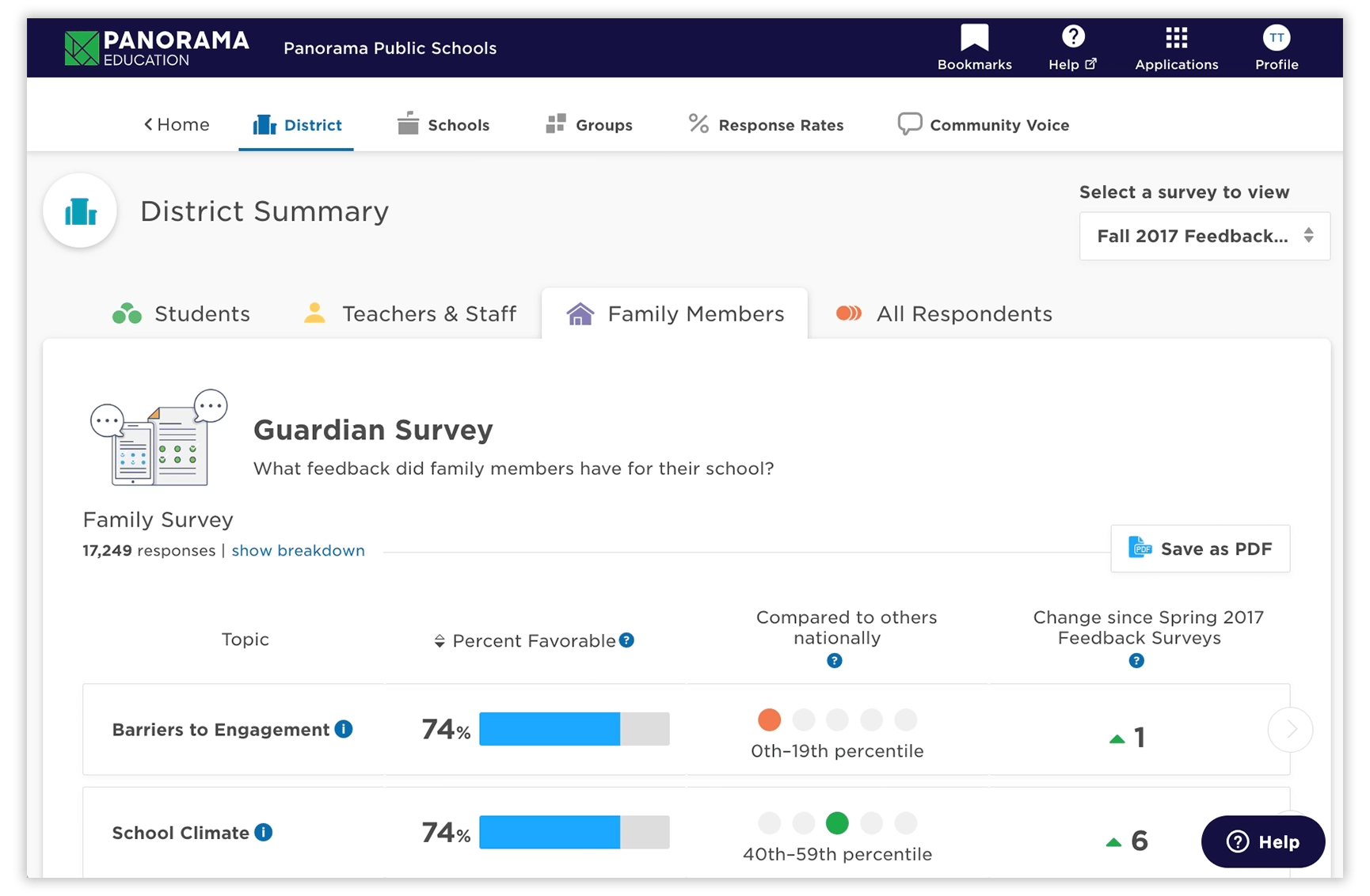When families and parents are involved in their child’s education, that child is more likely to succeed. This fact is at the heart of efforts to engage parents and families in schools.
Decades of research show that when schools successfully engage families, students earn higher grades, score higher on tests, develop better social skills, and are more likely to graduate. For educators looking to improve student outcomes, focusing on building parent involvement is a must.
Educators and administrators must prioritize efforts to foster strong partnerships with parents and families. By adopting actionable strategies to meet all parents where they are, school and district leaders will be able to build a strong family-school community.
Understand Parents' Needs with our Family Engagement Survey
What’s the Difference Between Parent Involvement and Parent Engagement?
Parent involvement and engagement are often used interchangeably, but they represent different levels of connection:
- Parent involvement includes activities such as attending parent-teacher conferences, volunteering for school events, or helping with classroom tasks. While important, involvement often remains surface-level.
- Parent engagement goes deeper and consists of active collaboration between parents and schools to support a child’s learning journey. Engaged parents communicate regularly with teachers, participate in decision-making processes, and contribute to creating a supportive learning environment at home.
While family engagement can lead to more substantial growth, family involvement is just as important, and can be the first step to creating an atmosphere where families are fully engaged.
Why Parent Involvement in Education Matters
Numerous studies have shown that family involvement can benefit all students, especially those less likely to succeed in school. Research underscores the transformative impact of parent involvement on student outcomes:
- Improved academic achievement: A comprehensive review by the American Psychological Association found that increased parental involvement correlates with higher academic performance, including better grades and standardized test scores.
- Higher attendance rates: Engaged parents contribute to improved school attendance and reduced absenteeism among students.
- Better behavioral outcomes: Parental involvement positively impacts students' social and emotional development, leading to improved behavior and reduced disciplinary issues. Adolescents whose parents monitor their academic and social activities have lower rates of delinquency and higher rates of social competence and academic growth.
- Enhanced Well-Being: Parent involvement fosters better mental health, as children feel supported both at home and at school.
Moreover, engaged parents contribute to a stronger school community by fostering better teacher-student and parent-school relationships. When families and schools work together, they build trust and create an environment where collaboration thrives.
Barriers to Family and Parent Involvement
Involving families is not as easy as sending a letter home or asking for volunteers at school events. Despite its importance, many schools face challenges in achieving effective parent involvement. In a Panorama Education survey of over 18,000 parents and guardians from diverse school communities across the country, several themes emerged in terms of common barriers to involvement for families.
According to our dataset, the most common barrier to involvement is a lack of time, with 54 percent of parents and guardians reporting that their busy schedule is a “medium” to “very large” problem for becoming involved in their child's school. Other common barriers to involvement include:
- Language or cultural differences: Families from diverse backgrounds may struggle to connect due to language barriers or unfamiliarity with school norms.
- Lack of information: Parents may not know how to engage meaningfully or feel unwelcome in school spaces. They may need guidance on how to communicate with the school or what is expected or encouraged.
- Lack of trust: Research shows that a lack of trust is often what keeps historically marginalized families (which includes families of language learners) from spending time at school. Parents may fear that adults at school will treat their children differently if they raise a concern.
- Transportation challenges: Families without reliable transportation will have difficulty reaching the school, especially if the school is located in an area without safe pedestrian access or public transportation.
- Childcare needs: Parents may also need childcare for their other children so they can participate in school activities or attend parent-teacher conferences.
Administrators and teachers can improve many of these barriers when they understand the underlying obstacle or challenge. Consider solutions like multilingual resources and translation services, shuttles or buses to schools for parents, flexible and virtual meeting times, and childcare options. Overall, educators must focus on creating welcoming environments through clear communication and understanding.
4 Proven Strategies to Increase Family and Parent Involvement
1. Invite Families to Share Feedback
Using a parent satisfaction survey or family engagement survey, administrators can invite caregivers to document their perceptions of their child's experience in school. The data gathered can help districts better understand the experience of all families in order to institute policy and programmatic changes accordingly.
Measure parents’ perceptions in areas like:
- School Fit: Families' perceptions of how well a school matches their child's developmental needs
- Family Efficacy: How confident families are with regard to key parenting skills
- School Climate: Perceptions of the overall social and learning climate of their child's school
- Barriers to Engagement: Factors that can create challenges for families to interact with their child's school.

Panorama's Family-School Relationships Survey (demo data displayed)
2. Bring Families Into the Decision-Making Process
After you have an understanding of where your district is starting with family involvement, make sure parents are a part of planning a solution. Successful family involvement programs are built on a foundation of joint decision-making and goal setting. Inviting families to take part in this work can increase parent involvement and reinforce that their involvement will have a direct impact on their children’s education and well-being.
Consider inviting parents to join councils or committees that are tasked with setting school policies or developing enrichment programs. Some districts create advisory committees composed of teachers, administrators, parents, and community leaders to solicit and provide input on educational initiatives and policy.
3. Establish Clear Communication Channels
Apart from the main social media platforms, tools such as Remind and ClassDojo make it possible for teachers to virtually bring parents into the classroom. These apps enable teachers and parents to communicate and share information quickly. Both options offer translation capabilities. Another app, Ready4K, offers evidence-based text messages for parents that can deliver an entire family involvement curriculum via SMS.
4. Host Workshops & Collaborative Events
Organize activities that encourage parents to work alongside educators, such as family literacy nights or science fairs. Teach parents how to support their child’s learning at home with sessions on topics like reading strategies or math problem-solving.
For example, Stough Elementary School in Wake County, NC, held a literacy-themed family night that ended up attracting more than double the average number of families who attend events. Not only did parents have their conferences with teachers, but they also participated in sessions about literacy strategies and how to better support their children at home.
In response to survey data about Hispanic parents feeling less engaged, Stough offered the presentations in Spanish and had multiple interpreters available. The school also provided dinner to remove barriers for families. The event was incredibly successful with 267 parents and guardians coming together to learn, connect, and enjoy a meal.
|
|
Next Steps for District Leaders
Creating a sustainable culture of parent involvement requires systemic effort and leadership commitment. District leaders should prioritize long-term parent engagement by training staff, setting goals, and tracking progress. Involve parents from the beginning with tools like Panorama’s family engagement survey to assess progress and identify areas for improvement.
If your district has laid the groundwork for parent involvement, look for ways to transition to engagement to better impact student success. By fostering deep, collaborative relationships with families, educators can unlock new levels of achievement and community strength. Now is the time for school and district leaders to evaluate their current practices, address barriers, and implement strategies that ensure every family feels empowered to support their child’s learning journey.







